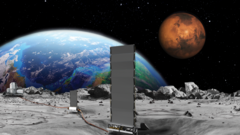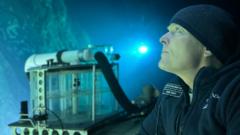Concerns mount over feasibility, funding, and the implications of lunar claims with competing nations pushing for exploration.
Nasa Aims for Lunar Nuclear Power by 2030 Amid Intense International Competition

Nasa Aims for Lunar Nuclear Power by 2030 Amid Intense International Competition
US space agency sets sights on a nuclear reactor on the Moon, raising geopolitical tensions.
In a bold move reflecting its aspirations for lunar colonization, NASA is accelerating its timeline to establish a nuclear reactor on the Moon by 2030. This initiative aims to support a sustainable human presence on the lunar surface and comes in response to similar ambitions by global rivals China and Russia, who potentially threaten to assert territorial claims on the Moon.
Acting NASA administrator Sean Duffy has emphasized the urgency of the project, indicating that a robust energy supply is critical not only for lunar activities but also for national security in space, as reported by Politico. Duffy's letter to NASA called for commercial proposals to develop a reactor capable of producing at least 100 kilowatts of power, a notable contrast to the megawatt capacity needed for a permanent lunar habitation.
The scenario raises eyebrows among scientists who question the practicality of both the technology and its funding, especially following substantial budget cuts to NASA. These financial constraints have left many skeptical about the feasibility of achieving such an ambitious timeline. The international race to explore the Moon is escalating, with countries like the US, China, Russia, India, and Japan all planning lunar missions aimed at long-term human settlements.
Experts argue that nuclear power represents a viable solution to the demands of sustaining life on the Moon, where 14 Earth days of continuous sunlight are followed by an equal stretch of darkness. "Relying solely on solar energy is insufficient for the energy demands of a lunar base," states Dr. Sungwoo Lim, a senior lecturer at the University of Surrey. While some researchers view the nuclear reactor project as a technological imperative, the geopolitical motivations behind the push leave them uneasy.
Despite the technical possibility of deploying such reactors by 2030, Professor Lionel Wilson of Lancaster University highlights that appropriate funding and a rigorous launch schedule through NASA's Artemis program are essential for success. Concurrently, safety concerns regarding the transportation of radioactive materials into space loom large, requiring stringent regulations.
Duffy's unexpected directive comes during a tumultuous period for NASA, marked by a 24% budget cut announced by the previous administration, impacting various key scientific initiatives, including the Mars Sample Return mission. This upwards trend of nationalism surrounding lunar exploration has stirred fears among the scientific community that the focus may shift from collaboration toward competition, stymieing genuine exploration efforts.
Amidst the hustle for lunar dominance, the Artemis accord—established by seven countries to promote cooperative principles in lunar exploration—offers a semblance of hope, although tensions remain regarding territorial claims, particularly in light of potential safety zones around lunar infrastructure. As Dr. Simeon Barber points out, the implications of constructing a nuclear reactor could unintentionally lay claims to specific lunar areas, inviting conflict over ownership amidst heightened international exploration efforts.
However, until the issues of infrastructure and transportation are resolved, the prospects of utilizing nuclear power on the Moon face significant obstacles. As NASA aims for its first moon crew launch under Artemis 3 in 2027, uncertainties loom about the ambitious plans for lunar nuclear power.
Acting NASA administrator Sean Duffy has emphasized the urgency of the project, indicating that a robust energy supply is critical not only for lunar activities but also for national security in space, as reported by Politico. Duffy's letter to NASA called for commercial proposals to develop a reactor capable of producing at least 100 kilowatts of power, a notable contrast to the megawatt capacity needed for a permanent lunar habitation.
The scenario raises eyebrows among scientists who question the practicality of both the technology and its funding, especially following substantial budget cuts to NASA. These financial constraints have left many skeptical about the feasibility of achieving such an ambitious timeline. The international race to explore the Moon is escalating, with countries like the US, China, Russia, India, and Japan all planning lunar missions aimed at long-term human settlements.
Experts argue that nuclear power represents a viable solution to the demands of sustaining life on the Moon, where 14 Earth days of continuous sunlight are followed by an equal stretch of darkness. "Relying solely on solar energy is insufficient for the energy demands of a lunar base," states Dr. Sungwoo Lim, a senior lecturer at the University of Surrey. While some researchers view the nuclear reactor project as a technological imperative, the geopolitical motivations behind the push leave them uneasy.
Despite the technical possibility of deploying such reactors by 2030, Professor Lionel Wilson of Lancaster University highlights that appropriate funding and a rigorous launch schedule through NASA's Artemis program are essential for success. Concurrently, safety concerns regarding the transportation of radioactive materials into space loom large, requiring stringent regulations.
Duffy's unexpected directive comes during a tumultuous period for NASA, marked by a 24% budget cut announced by the previous administration, impacting various key scientific initiatives, including the Mars Sample Return mission. This upwards trend of nationalism surrounding lunar exploration has stirred fears among the scientific community that the focus may shift from collaboration toward competition, stymieing genuine exploration efforts.
Amidst the hustle for lunar dominance, the Artemis accord—established by seven countries to promote cooperative principles in lunar exploration—offers a semblance of hope, although tensions remain regarding territorial claims, particularly in light of potential safety zones around lunar infrastructure. As Dr. Simeon Barber points out, the implications of constructing a nuclear reactor could unintentionally lay claims to specific lunar areas, inviting conflict over ownership amidst heightened international exploration efforts.
However, until the issues of infrastructure and transportation are resolved, the prospects of utilizing nuclear power on the Moon face significant obstacles. As NASA aims for its first moon crew launch under Artemis 3 in 2027, uncertainties loom about the ambitious plans for lunar nuclear power.


















